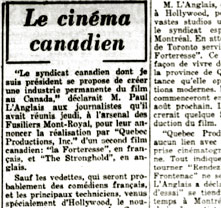Quebecers in Hollywood
-

Le Petit journal, 12 avril 1936, p.23
Source : Bibliothèque et Archives nationale du Québec
-

Le Petit Journal, 23 June 1946, p.38
Source : Bibliothèque et Archives nationale du Québec
-

Le Petit journal, 1 January 1933, p.16.
Source : Bibliothèque et Archives nationale du Québec
-

Le Petit journal, 12 April 1936, p.21
Source : Bibliothèque et Archives nationale du Québec
The exodus of Quebec talent to the United States was already well underway when the film industry converted to sound. One Quebecer who left to try his chance south of the border in the silent era was Mack Sennett, born Michael Sinnott near Richmond in 1880. In 1912 Sennett took over the Keystone studio, which specialised in comedies. In 1914, he was the first to take on a young British music-hall performer named Charlie Chaplin. Sennett was very successful, producing several hundred comedies right up to the early years of the talkies. He was indisputably one of the most important figures in Hollywood in the 1910s and 20s.
Several Quebec actresses began Hollywood careers in the early years of the talkies. Norma Shearer, from Westmount, became one of the biggest stars of the 1930s. Pauline Garon and Fifi D’Orsay also attracted attention in several Hollywood films. All three received a lot of attention whenever they returned to Quebec. Alys Robi and Germaine Giroux also tried their luck in the United States, but without success.
Two French-speaking Quebecers, Henri Letondal and Paul Dupuis, also had interesting careers abroad. Letondal, already well-known for the radio programs he wrote and performed for the Montreal radio station CKAC, left to try his luck in Hollywood in the 1940s. He landed a number of small roles which required a French accent, some of them in major films. He can be seen alongside Marilyn Monroe in Monkey Business and Gentlemen Prefer Blondes. Paul Dupuis, for his part, played in a dozen or so British films. He also worked in France and Quebec, most notably in the case of the latter in La forteresse and Tit-coq.
The roles played by Garon, D’Orsay and Letondal in Hollywood were closer to the stereotype of the “Frenchie” than to that of the French Canadian well-known to fans of North West Mounted Police dramas. They didn’t play trappers wearing toques and checked shirts, but Frenchmen from France. Their characters spoke rudimentary English and lisped. The “Latin” aspect of their characters was also evident in their sexual freedom.
The most famous English-speaking Quebecer who made a career in Hollywood was undoubtedly the actor Glenn Ford (born Gwyllyn Samuel Newton), who appeared in more than a hundred films between 1937 and 1990. Born on 1 May 1916 at the Jeffrey Hale Hospital in Quebec City, Ford spent his early years in Quebec City and Sainte-Christine D’Auvergne before emigrating with his family to California in 1924. His movie debut came in the late 1930s, and he became very famous after the Second World War. One of his best-known roles was alongside Rita Hayworth in Gilda.
Mark Robson, born in Montreal in 1913, was another English speaker who succeeded in Hollywood. He began working in 1932 for Fox and later for RKO, where he worked on the editing of Citizen Kane. He later directed horror films for Val Lewton in the 1940s.
The Quebec with the honour of winning the largest number of Academy Awards is Douglas Shearer, Norma’s brother. Shearer won no fewer than eleven Oscars for his work as a sound engineer.